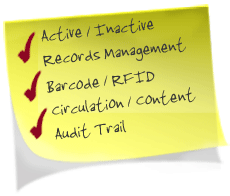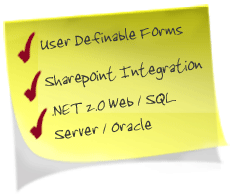Contact UsThoroughbred Technologies |

OPUS iNetThe Next Generation of Records Management Software
At the heart of OPUS iNet is its foundation in traditional records management including the next generation of compliancy, content and circulation management. Industrial strength security protects your most critical data, yet allows any level of user to utilize the system based on their prospective roles. Compliance and Record Retention features allow users to implement internal controls to satisfy requirements of the Sarbanes-Oxley Act of 2002. Electronic RecordsElectronic records can be captured at time of creation through the OPUS iNet Microsoft Office interface or uploaded directly through OPUS iNet. All electronic documents can be indexed and have Retention Schedules attached to manage the life of the document. Corporate records are becoming increasingly difficult to manage based on today's highly regulated world. Whether you're tracking legal documents, patient files, collateral loan documents, or personnel files, OPUS iNet will provide the customized solution to your problem. OPUS iNet seamlessly integrates with Microsoft Sharepoint Services to expand the RIM features and allows your OPUS iNet Retention Schedule to be utilized in Sharepoint. Archival or Active Records Tracking
The circulation tools in OPUS iNet takes advantage of barcode and RFID technologies to allow for maximum staff productivity. In addition to advanced file room tools, OPUS iNet also provides a complete set of tools for managing your own Record Center, which includes space management and support for Windows CE portable barcode devices. Advanced Features and Functionality
Indexing Form and Report Customization
Once forms have been defined, they can be used for data entry/editing and as search forms. Forms can be linked to user definable groupings or departmental categories with create, edit and view security permissions tied to each form. OPUS iNet includes two of the most comprehensive solutions for RIM reporting in the industry. Users can define their own Ad Hoc reports, which include multiple grouping levels as well as detail fields. Columns can be customized by sizing, font, and color. Multiple levels of sorting, including terminal digit sorting can be enabled for these reports. OPUS iNet also includes numerous pre-defined reports that are included under the groupings of Administration, Inventory, Circulation, and Retention. OPUS iNet pre-defined reports are built and ship with the runtime version of Crystal Report Writer. Each of these reports can be modified and additional reports can be added to the OPUS iNet report interface via OPUS iNet administration. Barcode TrackingPerform many circulatioin tasks, such as Check Out, Check In, Location Moves, Inventory and others with barcode readers. OPUS iNet will print user defined barcode labels and interface with a number of different Portable Barecode Readers. All barcode transactions captured in history for viewing or reporting. Technical OverviewBased on the industrial strength of OPUS 4.5, OPUS iNet is built for large item inventory levels (10 million+) and high transaction volume. Built on Microsoft.NET and JAVA 2 technologies, OPUS iNet exploits the latest in today's web based technologies, including AJAX, SOAP and XML. |

 OPUS
iNet incorporates all the functionality of managing physical
active and in-active records with the capture and management of electronic
records, including Email, Microsoft Office documents, images, and other
electronic files. OPUS iNet is 100% web based, deployable to the entire
enterprise or for strategic departmental solutions.
OPUS
iNet incorporates all the functionality of managing physical
active and in-active records with the capture and management of electronic
records, including Email, Microsoft Office documents, images, and other
electronic files. OPUS iNet is 100% web based, deployable to the entire
enterprise or for strategic departmental solutions. OPUS
iNet provides a cradle to grave solution for your records. With one
product a company can manage the highly active status of an early record
as it moves about within a workflow, but also manage its final stage
as it resides in the archive center.
OPUS
iNet provides a cradle to grave solution for your records. With one
product a company can manage the highly active status of an early record
as it moves about within a workflow, but also manage its final stage
as it resides in the archive center. OPUS
iNet allows administrators to configure their indexing forms for as
many object types or record types as they wish. There is an unlimited
number of data elements (fields) which can be tracked and each element
can have its own set of business rules.
OPUS
iNet allows administrators to configure their indexing forms for as
many object types or record types as they wish. There is an unlimited
number of data elements (fields) which can be tracked and each element
can have its own set of business rules.